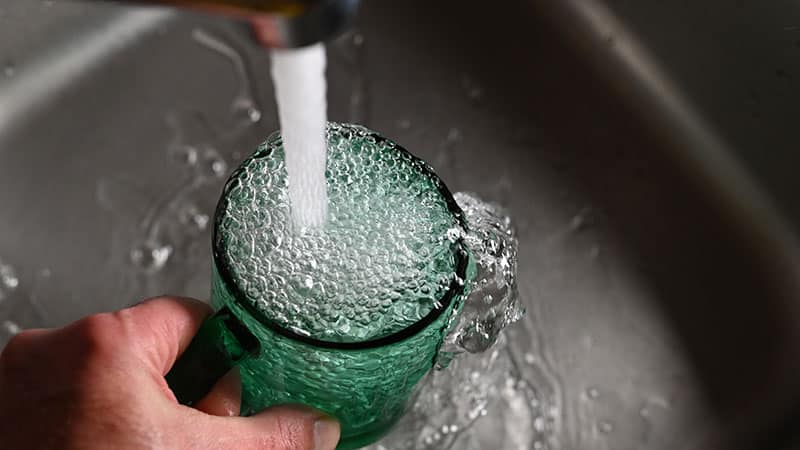Asbestos in Water: Is Our Drinking Water Safe?
It is now well-established that the inhalation or ingestion of asbestos can pose extremely serious health risks – a consensus that led to the complete banning of asbestos in the UK in 1999. However, there is still not always an understanding of the sheer breadth of ways in which someone can potentially come into contact with the lethal substance.

For many people who have some degree of asbestos awareness, it may be obvious to them that asbestos can be a health risk when it is disturbed in a building in which it is present – for example, as a consequence of renovation or demolition work.
Asbestos exposure in such circumstances is known to lead in some people to the eventual development of asbestos-related health conditions, ranging from asbestosis to mesothelioma. There is, however, another possible source of asbestos exposure that remains too widely ignored, or not even considered: asbestos fibres in drinking water.
How great a risk is asbestos in drinking water?
The risk of asbestos fibres being found in drinking water may not have been talked about much in recent years, but it was being raised about half a century ago in the United States, when studies evaluated the dangerous substance’s presence in such a context.
However, the exact source of such a risk can differ across geographies. On the west coast of america, for example, the main source of asbestos-polluted water is known to be asbestos rocks. In Europe, though, the risk arises largely from pipes built in asbestos cement, with the UK alone estimated to have more than 257,000 kilometres of asbestos-cement water pipes. In Italy, there is thought to be over 125,000 kilometres of such piping.
Deducing an exact level of risk to human health arising from this situation is tricky. The United States Environmental Protection Agency (EPA) has suggested seven million fibres (>10μm) as a threshold value, above which the risk increases of developing intestinal polyps. However, only in rodent models has this threshold value been defined.
Mesothelioma research points to a potential hidden risk
An analysis from the Italian National Mesothelioma Register – said to be accurate – found that only 80% of mesotheliomas show a previous exposure to asbestos. For the rest of the cases, it was not known what the source of the exposure was, which indicates there may be hidden exposure sources in our environment that haven’t yet received the merited attention.
However, it has been difficult in the past to ascertain the nature and extent of mesothelioma risk. It has been suggested by some authors that there is a threshold value of “fibre saturation” of the pleural spaces, and that beyond this threshold, the risk is heightened.
Meanwhile, the Italian Consensus Conference on Mesothelioma certified a strong correlation between asbestos exposure and the risk of developing mesothelioma, with the incidence of the disease being doubled – or the time of disease development greatly shortened – at higher levels of exposure.
It has also long been agreed, however, that in the case of pleural mesothelioma, it is almost always inhalation that leads to the associated asbestos fibres being taken into the body. When it comes to gastrointestinal (GI) cancers, however, exposure to asbestos can occur via inhalation or ingestion, as could theoretically be the case with drinking water.
Asbestos fibres being passed out through urine?
One would probably imagine that asbestos fibres getting to the GI tract would pose a damage risk primarily to the organs in this part of the body. This, in turn, raises the question of whether the GI mucosa might absorb such ingested fibres.
Research published in Science in 1979 provides invaluable insight on this question. For this research, healthy volunteers drank water from Minnesota’s Superior lake, which was subject to widespread asbestos contamination. Not only were fibres detected in the volunteers’ urine, but the presence of those fibres was detected for at least two months after the last intake.
The fact that the concentration of asbestos fibres in the volunteers’ urine was about 0.1% of those ingested, indicated that the fibres can indeed be absorbed by the GI mucosa, and particularly the colon. Animal studies have found that fibres are able to penetrate the intestinal mucosa and migrate to peritoneal sierosa, which has raised fears of this being a potential cause of peritoneal mesothelioma.
Asbestos in drinking water may pose a greater risk than is generally realised
Ecological studies have been carried out down the years that have attempted to shed greater light on the relationship between GI cancer and asbestos exposure in certain populations.
Some of this research has actually suggested a negative association between the two, although for some studies, that was not the case. A large cohort study in San Francisco Bay, for instance, showed a direct correlation between ingested fibres of asbestos in drinking water and a significant rise in stomach, oesophageal and colon cancers.
Meanwhile, a Canadian cohort study found that subjects exposed to large quantities of asbestos fibres – amounting to 1.2 x 109L – showed a heightened mortality rate from stomach and pancreatic cancer, compared to the cohort with lower fibres in water.
With as many as 33 million fibres/L having been detected in drinking-water supplies in the Netherlands, and a progressive increase in fibres in drinking water in Italy over the last two decades having brought about peaks of more than 100,000 fibres/L in Modena city, there would seem evidence to suggest the risk of asbestos in drinking water should be carefully thought about.
Would you like to request a competitive quote for asbestos services from a company that is renowned for its high-quality and great-value solutions for managing this substance safely? If so, please do not hesitate to give Oracle Solutions a call or to send us an email.
